July 4, 2016
On my last day on the Dublin Coast, I awake to a grey, windy, damp morning. It doesn’t look very promising as Simon, Jeanne, and I climb into the car for the short drive to Killruddery House.
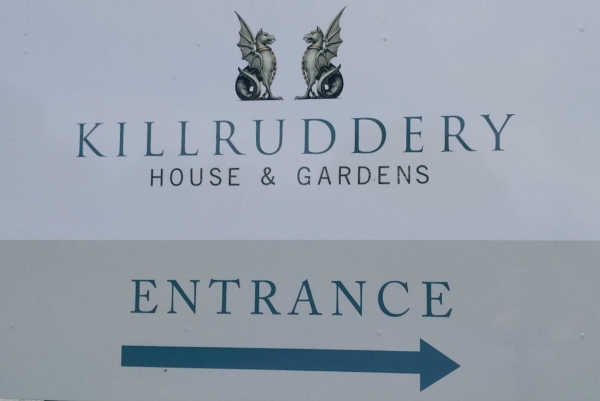
Unlike Powerscourt, which has the sterile feeling of a showpiece that is no longer lived in, Killruddery House is a living, working estate complete with a home farm, a farmer’s market on Saturdays, special events, and the Brabazon family still in residence. Jeanne especially is taken with the idea that we might spot Lord Ardee, the 15th Earl of Meath’s son.
Our first port of call are the Tea Rooms, located in what used to be the dairy.
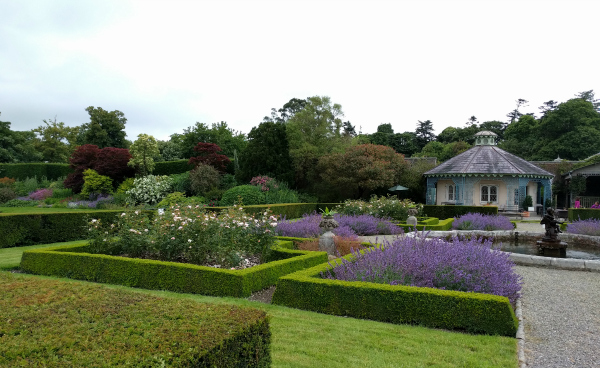
It’s just after opening hours, so we have the outdoor terrace mostly to ourselves. Jeanne tells me that the nice-looking bloke in trousers and a tweed jacket with patched elbows we passed at the entry is Lord Ardee, son and heir to the current Lord Meath. I have an impression of curly hair and Englishness, but that’s it.
As I sip my delicious peppermint tea, the grounds are a bustle of activity. Crews are dismantling food trucks, port-a-loos, and music stages from the music festival that Killruddery House hosted over the weekend. Although I understand the economic drivers for hosting a modern music festival on the grounds, there’s still something incongruous about a row of port-a-loos right down the main garden walk.
Breakfast finished, I hug Jeanne and Simon goodbye and thank them for a wonderful weekend. They’re headed back to town, while I’m off to explore the estate.
My first stops are the walled kitchen garden and the orchard. The Brabazon family has been farming 750 acres since their arrival in 1618, and somehow they’ve managed to keep all those acres in the family. It’s still a working farm, with cattle, sheep, tillage, and forestry.
I pass a small apple orchard on my left, and row after row of kitchen vegetables in the walled garden on my right. In the middle of the apple orchard is a clearing with a giant sandbox, and several mothers or nannies are already seated on benches watching their kids play.
There are chicken runs built among the apple trees to separate the clearing from the main walking path.
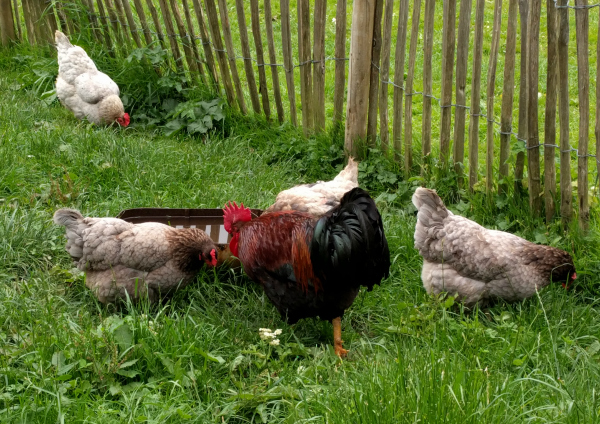
And further on is the best surprise of all: a mother pig and her piglets!
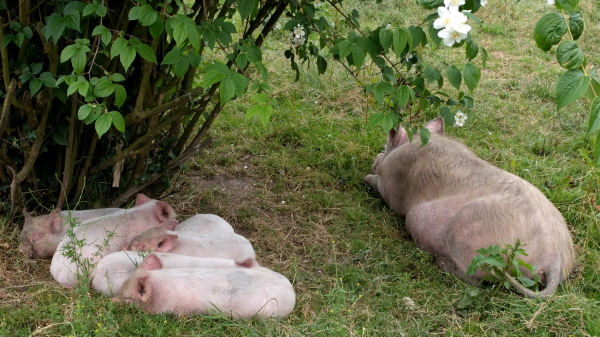
It’s fairly quiet in this corner of the estate, and I spend several minutes watching the piglets sleep and taking in my surroundings. There’s a goose run behind me, tractors in the distance, and curious little boys who want nothing more than to wake the piglets up.
As I retrace my steps back through the walled garden, I discover that it’s is a recent project, restored in 2011 and supplying the tea rooms with vegetables, salads, herbs, and fruits as they become available. I’m absurdly delighted by this, along with the fact that they host a local farmer’s market here every Saturday.
Once back at the main entry point, it’s time to explore the formal gardens.
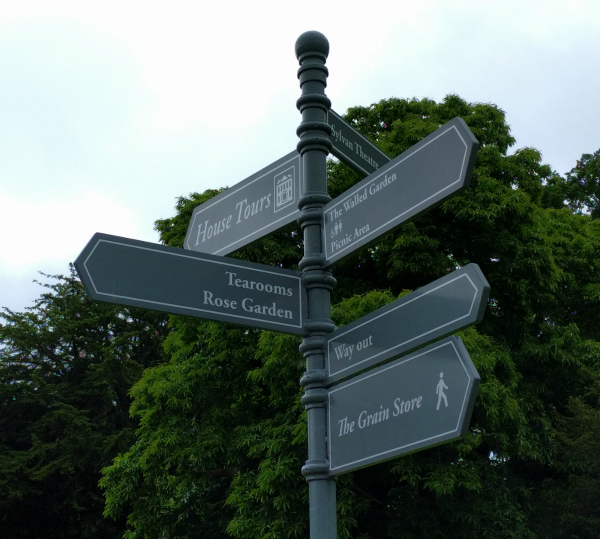
The sky is still grey and looming, but that doesn’t stop me from appreciating the view across the lawn to the orangery.
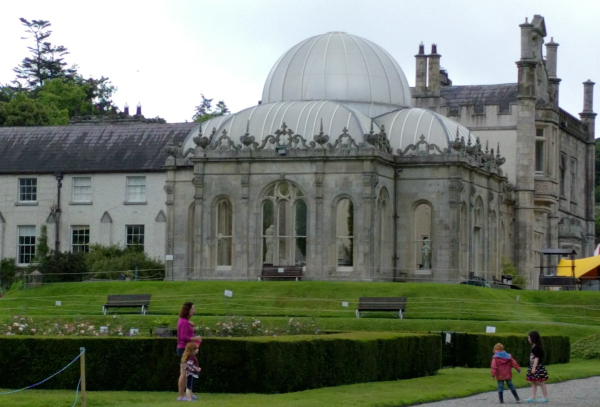
Even more amazing is this fairy tree.
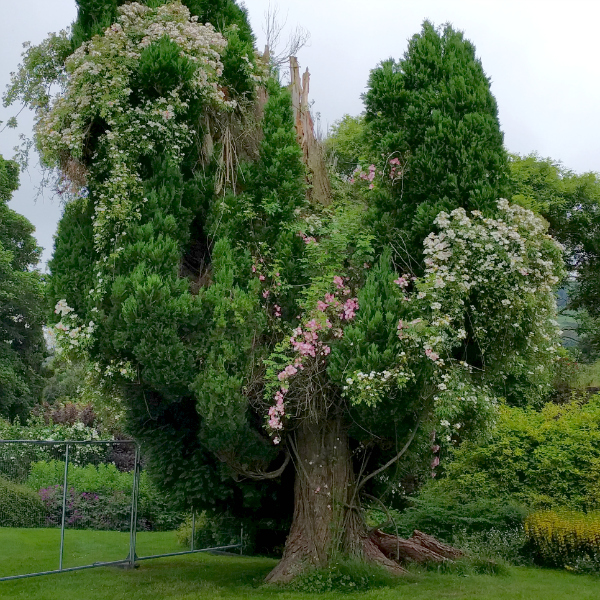
Even in the grey morning light, there’s something otherwordly about this tree. It seems somehow too picture perfect, as if it will disappear in the blink of an eye.
Past the fairy tree is a lily pond, completely enclosed by a beech hedge many feet high. The only way in or out are two tunnels cut into the living wood.
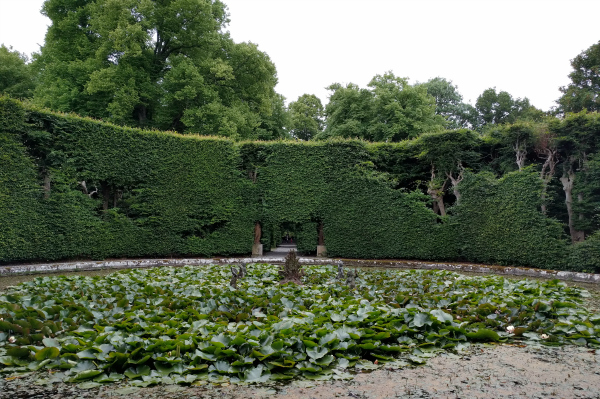
I follow the pathway through the hedge at the far end. Beyond is the start of the farm itself: woods and fields and the occasional statue thrown in for artistic effect. I want to explore this part of the grounds, but not until I’ve finished exploring the formal gardens.
Back through the lily pond hedge, I discover a natural amphitheater nearby.
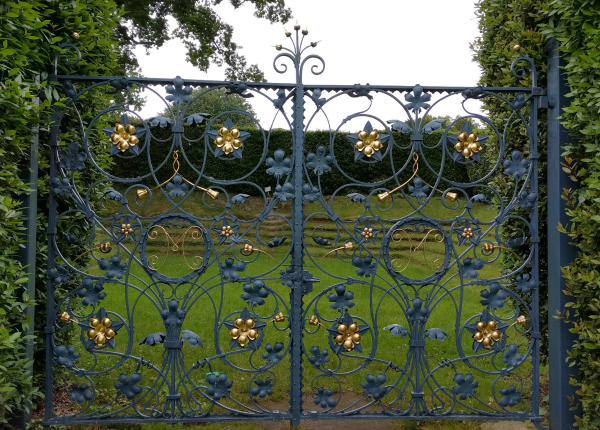
Through the gilded garden gate I can see terraces of seats cut into the natural depression to form an outdoor theatre in the round. I find out later that the amphitheater is still used (though probably only when the ground’s dried out enough to sit on!)
Once past the amphitheater I’m at the back of the main house. Two broad avenues stretch away to the farm, with two canals between them. One canal is mostly clear, but the other is covered in lily pads. There’s a pond at the far end, and the view back towards the house is lovely.
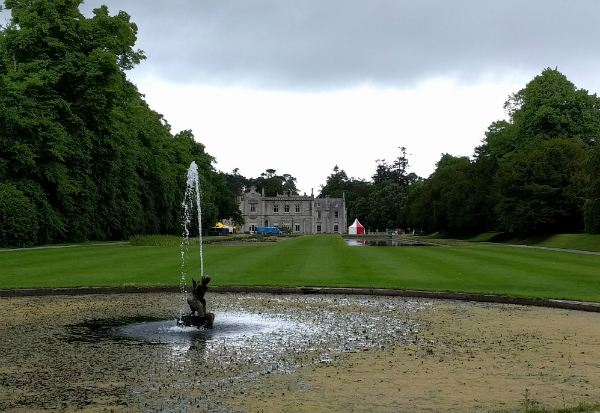
I’m at the edge of the formal grounds now. Beyond me are fields and woods stretching all the way to Little Sugar Loaf Mountain.
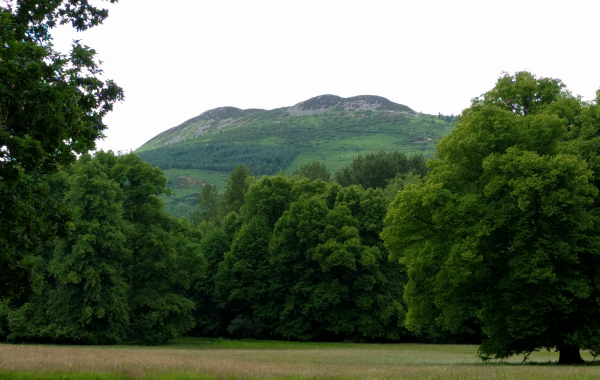
A man-made ditch divides the house from the rest of the estate.
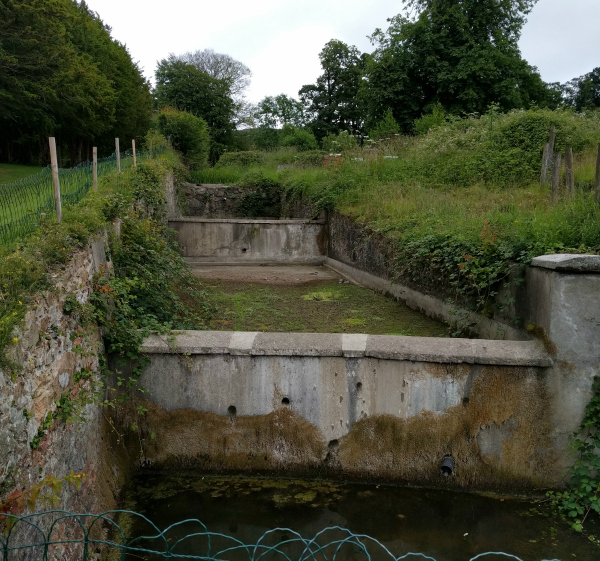
I’m unexpectedly captivated by the simplicity of the ditch, mostly dry in this summer season, and how it controls the flow of water mostly with gravity.
An avenue of very stately trees beacons me back towards the house
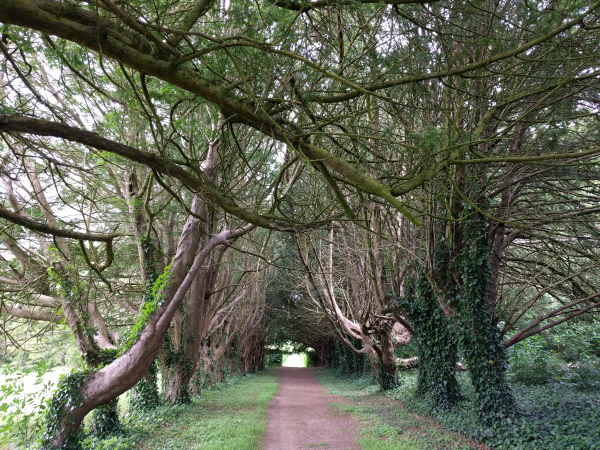
only to stop abruptly at the entrance to the Angles. Also known as the Goose Feet, the Angles are a geometric pattern of maze-like hedges laid out in one corner of the garden.
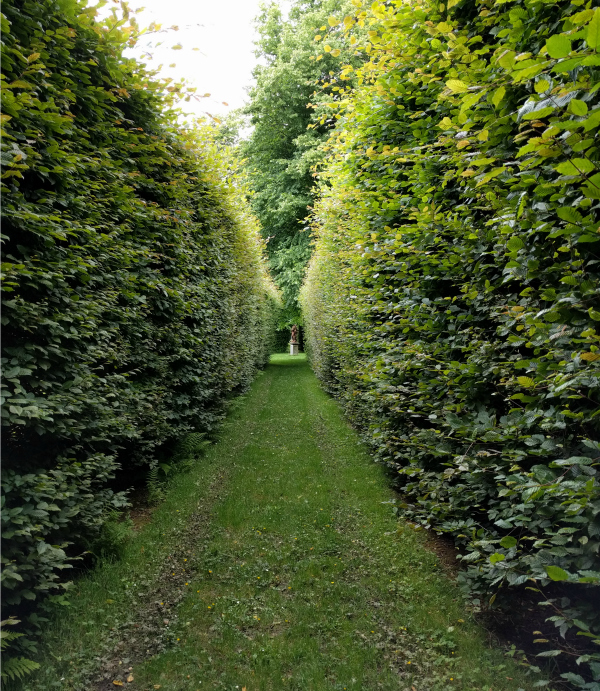
Something about the stillness in the air, the height of the hedges, and the grey morning make me think of the maze from the Triwizard Tournament in Harry Potter and the Goblet of Fire. Harry, Cedric, Fleur, and Viktor must’ve seen something very similar as they entered the maze, although this version is blissfully free of sphinxes, beasties, or man-killing plants.
A few minutes later, I exit the Angles and turn uphill towards the rock garden, the highest point on the estate.
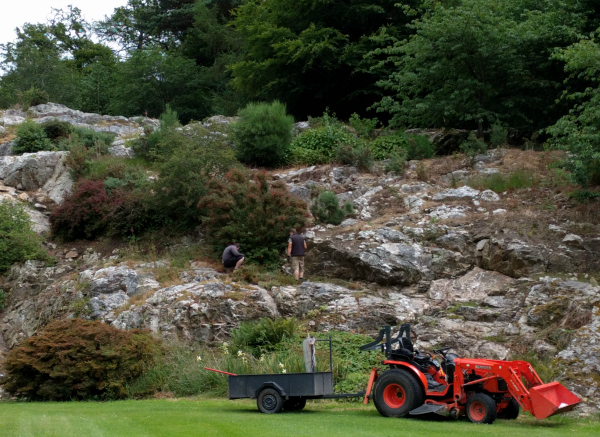
I don’t get very far before I’m completely distracted by this folly off to my right.
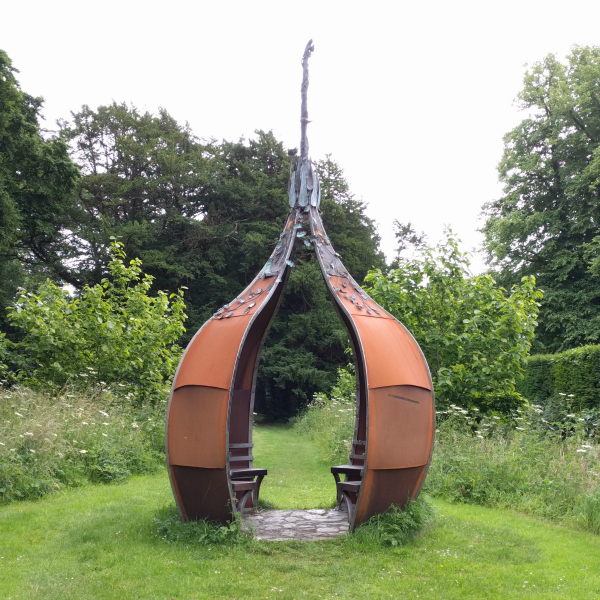
It isn’t marked on my map, so I call it the pumpkin folly. It looks like something out of a Disney movie, as if it would grow wheels and horses and become a carriage at any moment.
A quick glance at my phone tells me I have five minutes to make my way to the front of the house, where I’ll be met by a guide for a tour of the interior.
My first view of the front of the house is suitably impressive.
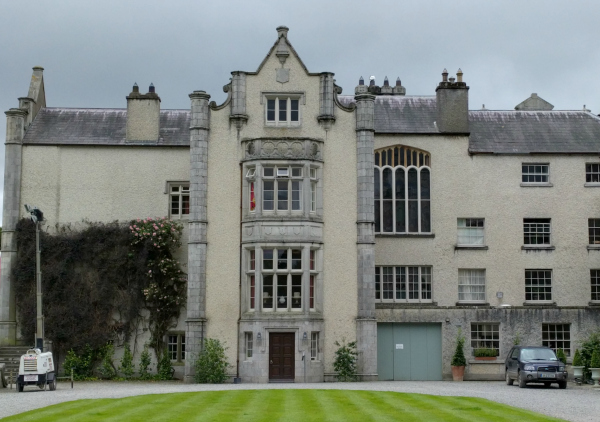
I find out later from my guide that originally the front of the house extended out much further. Unfortunately, when the 14th Earl’s family moved in after WWII, they found that almost all of the original 1618 portions of the house were infected with dry rot. A decision was made to demolish the infested portion of the house, including the original grand entrance. They were able to retain and save the library and drawing room.
The entrance as I see it today is therefore not nearly as grandiose as it would have been prior to the demolition, but it is nevertheless impressive.
To my right is a long low building, like a gallery, and at the end is a clock tower with a gatehouse into the courtyard beyond.
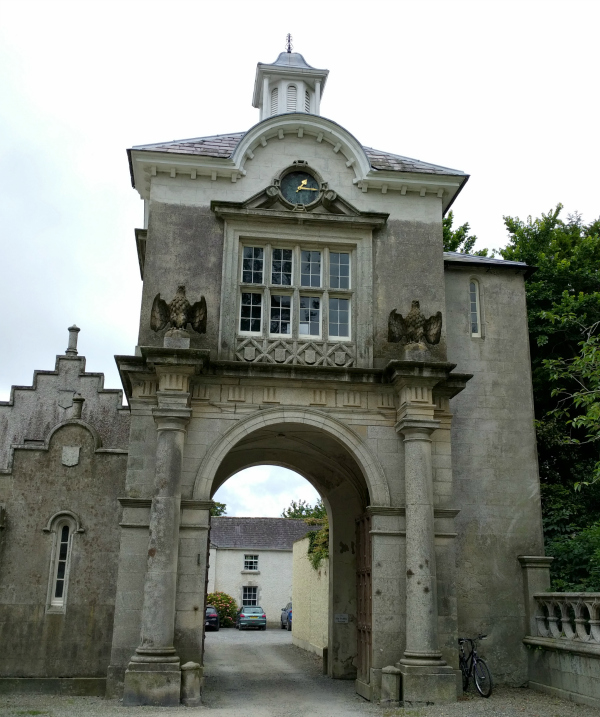
My guide tells me later that the gallery-like building was constructed to hide all the comings and goings of the side court from visitors approaching the house, and also to provide a covered walkway for the ladies of the house as they walked to their carriages or cars.
She also tells me that around the turn of the 20th century, the 13th Earl of Meath was very interested in technology – gears, mechanized contraptions, etc. He designed a water clock and housed it in this tower. Over the years it became a bit run down, but it’s now been restored.
It’s now just past 2 pm, and I’m watching a team of people hard at work dismantling the main festival stage nearby when I see Lord Ardee again. This time he’s carrying a car seat, but he smiles when he sees me and says something about watching the workmen.
It’s a brief encounter, but I like Lord Ardee and his wife. It’s clear from my printed guide and map that they care deeply about their home, and have done a wonderful job balancing the privacy of family life and their family’s legacy by also keeping the estate viable and (one hopes) prosperous in this modern age.
A few minutes later the door to the house opens. To my delight, I am the only person on the tour. Even more wonderful, there’s no one on the 3 pm tour either, so my guide and I take our time wandering through the public room. My guide me stories about the Brabazon family, past and present, and I learn that the current Earl and his wife don’t live in the main house. Lord and Lady Ardee do, however, along with their three children.
The house is marvelous decorated, of course, with lots of china tucked into tasteful corner hatches. The library smells of old books and has a massive desk at one end, just as a library ought.
One of the ladies of the house (Lord Ardee’s grandmother, I believe) dedicated years of her life to repainting, by hand, the intricate plaster work on the drawing room ceiling. The carpet in the drawing room is probably one of the only carpets of its kind made in Ireland, not France, and is therefore quite unique. This doesn’t stop us from walking across said carpet, and I can’t help feeling like I’m walking on a priceless museum piece.
In the main hall, there’s a Brabazon family tree dating back to 1618, and paintings of several of the house’s previous inhabitants. It’s clear that my guide loves this house, and loves learning about what’s inside. Several of her stories begin with “we used to think X about this, but an expert came to visit a few years back and told us it’s really Y.” Lady Meath certainly knew what she was about when she asked my guide to volunteer at the house.
Our last stop on the tour is the orangery, which is just as delightful inside as it looked from the outside. It’s warmer than the main house, and there are statues and a sense of lightness about it. I can easily see small concerts being held here, and strolling out onto the back terrace afterwards.
After thanking my guide profusely for the extended tour, I step out onto that back terrace. The sun has finally started to break up the clouds, and with a little luck it may turn into a lovely warm summer afternoon.
I find a bench near the fairy tree and soak up the atmosphere of Killruddery House. Powerscourt Estate was impressive because of its sheer size, scope, and opulence. But I must say I like Killruddery House better. It feels lived in and alive in a way that Powerscourt does not.
There’s a community here, from the guides who volunteer at the house, to the gardeners who work on the estate, to the vendors who come every weekend for the farmer’s market. There’s a sense of everyone working together to keep this estate true to its heritage, and also relevant and involved in the local community today.
With great reluctance, I leave my bench and after a brief tour of the gift shop, begin walking back into town. My magical weekend at the coast is nearing its end. All that’s left is to catch the train in Bray back to Dublin, and my bus from Dublin back to Belturbet.
As I make my way into Bray, I pass a couple of horses grazing just off the main road.
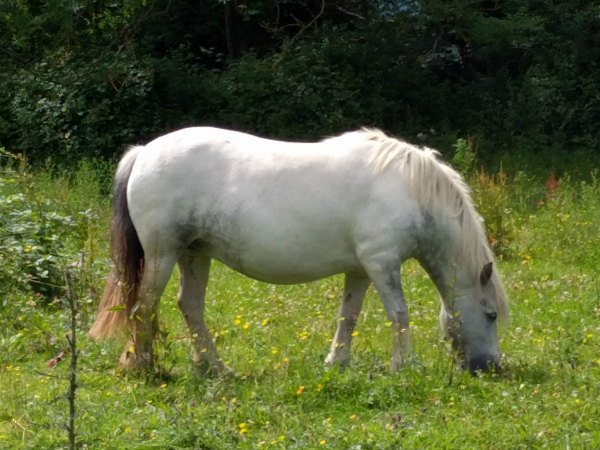
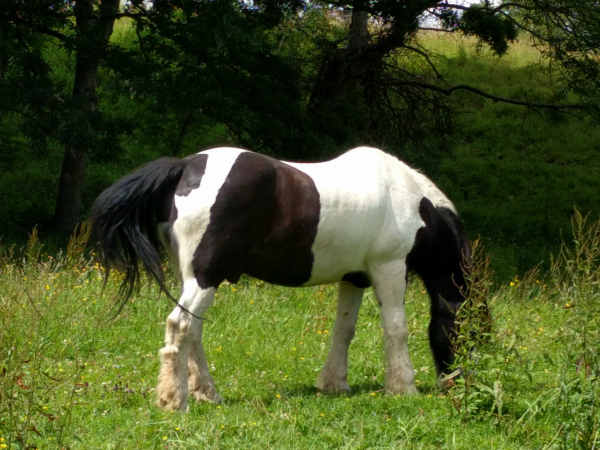
When I get to Bray, I wander slowly along the sea-side promenade, amusing myself with people-watching. It’s a glorious sunny summer afternoon, and everyone’s out getting some much-needed Vitamin D.
It’s only later, as I’m home and checking Facebook, that I remember today is Independence Day. I haven’t been home for a July 4 celebration in a few years, and yet the 4th of July has always been one of my favorite holidays. I love the fireworks, the food, and getting together with friends. Mostly I love the music: the 1812 overture with fireworks going off, the American folk medleys, and the national 4th of July concert from the capitol.
Luckily, PBS has some clips of previous concerts on their website. Watching them alleviates my sudden bout of homesickness, and I fall into bed deeply satisfied with my first weekend away from Belturbet.
Up next: A pilgrimage to BallyKissangel.

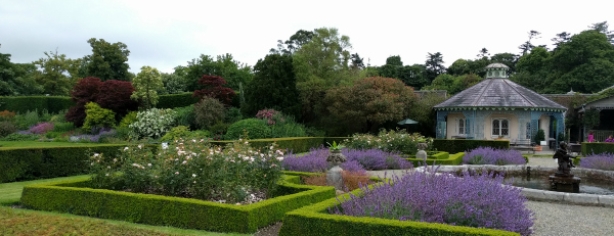









Getting all emotional over a “tune” written by a Russian about an 1812 fort bombardment during a “Press Gang Protest”?
The Brabazon family certainly did well in supporting Henry VIII — the Catholic Church supplied them with rather nice properties. Well done for a Kentish family from the Brabant duchy in Normandy…
A very nice estate — wonder how (their) children can grow up to be “normal”, living in a showplace with little real privacy? Of course, they wouldn’t have had privacy hundreds of years ago — too many servants, etc.
A truly great piece of music rises above its historical origins to speak to its listeners across the ages. I will forever associate the 4th of July with the 1812 overture being played by an orchestra as the fireworks begin to explode over the river. I experienced that every summer I stayed at my college campus, and I miss it every year I’m not there.
Lady Ardee was an accountant before she married, so I suspect their children are getting as normal an upbringing as she can give them. There’s quite a bit of privacy – only a few rooms of the house are open to the public, and there’s lots of space on the estate aside from the formal gardens. They’ll probably grow up more well adjusted than some kids, probably with more social skills too as they’re used to people coming and going.